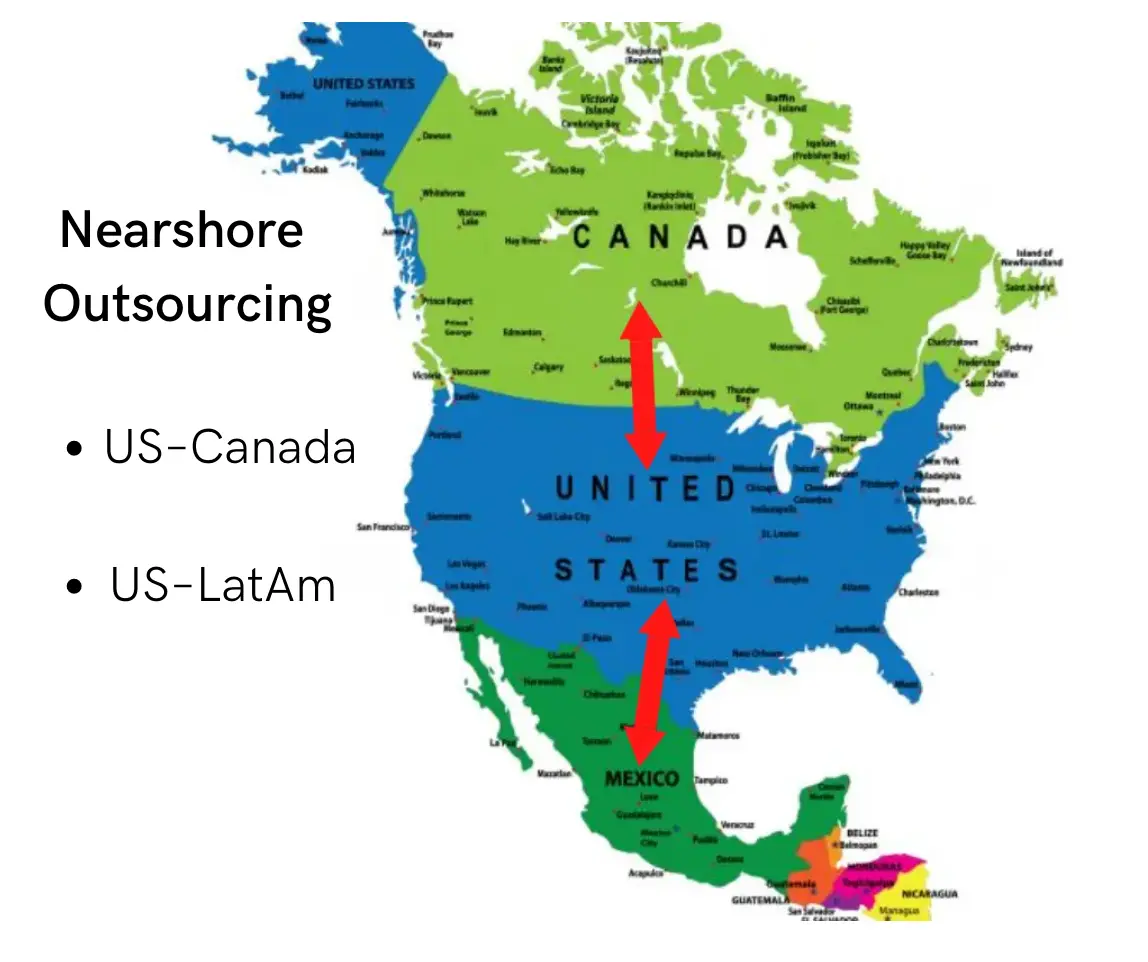Key Takeaways:
- There are five remote hiring models to consider when expanding your team: freelance hiring, global delivery teams, staff augmentation, dedicated teams (outsourcing), and nearshore hiring.
- Each remote hiring model offers unique trade-offs in cost efficiency, management control, work hours alignment, and team integration. Understanding these differences is crucial for selecting an approach that aligns with your company’s priorities and project requirements.
- Opt for freelancers for short-term projects, global teams for continuous operations, staff augmentation for temporary scaling, dedicated teams for standalone projects, and nearshore hiring for long-term team expansion with significant cost savings while maintaining real-time collaboration.
Remote hiring has moved from “nice option” to “strategic necessity” for many growing companies. Whether you’re struggling to find specific skills locally, facing budget constraints with US-based salaries, or simply running out of office space, looking beyond your local market just makes sense.
But not all remote hiring approaches deliver the same results. Here’s a breakdown of the five main remote hiring models so you can determine which one actually makes sense for your business.
1. Freelance Model: Fast But Unpredictable
If you need specialized skills for short-term projects or occasional work, hiring freelancers can be a great flexible, cost-effective solution.

Advantages of the freelance model
Quick hiring
While hiring a full-time employee for a highly skilled position can take months, bringing on a freelancer often happens within days. You can post a job on platforms like Upwork or Fiverr today and potentially have someone working on your project by the end of the week.
Relatively easy to find talent
Many top performers have moved into freelancing for better work-life balance and career autonomy. Millions of skilled professionals across different specializations are accessible through freelance marketplaces or through direct networking.
Cost-effective
Although their hourly rates may look high, working with freelancers typically costs less than hiring full-time employees because you’re not covering benefits, equipment, office space, or employer taxes.
You also have the flexibility of fixed-price arrangements depending on your project needs.
Disadvantages of the freelance model
Unreliable availability
Many freelancers juggle multiple clients and projects simultaneously. When your urgent task collides with three other client deadlines, you might find yourself deprioritized—or worse, ghosted entirely.
Limited control
Since freelancers work independently, you have minimal oversight of their day-to-day activities. This requires a leap of faith that they’ll deliver as promised.
Security concerns
Providing freelancers access to your systems creates potential data security risks. While most freelancers are trustworthy professionals, you’re still sharing company information with someone who isn’t fully integrated into your organization.
2. Global Delivery Model: Worldwide Talent, Asynchronous Work
The global delivery model involves hiring full-time employees from countries worldwide, regardless of time zone alignment.

Advantages of the global team model
Expansive talent pool
By removing geographic limitations, you can truly hire the best person for each role, no matter where they live.
Cultural diversity
Building a team with varied cultural perspectives often leads to more innovative problem-solving and product development.
24/7 operations
With team members across different time zones, you can implement “follow-the-sun” workflows where projects progress around the clock. This model works particularly well for support teams, development handoffs, or businesses with global customers.
Disadvantages of the global team model
Complex coordination
Managing a team spread across multiple time zones requires sophisticated workflows and communication protocols.
Default to asynchronous work
Real-time collaboration becomes challenging when team members have limited or no overlap in working hours. Meetings may require some team members to join very early or very late in their day.
Technology investment
For this model to succeed, you’ll need to invest in robust communication and project management tools to bridge the gaps created by geography and time.
3. Staff Augmentation: Plugging Skill Gaps
Staff augmentation involves bringing in professionals who are employed by a third-party provider but work directly with your team. These “borrowed” team members plug into your organization temporarily, following your processes and direction while technically remaining employees of the third-party agency.
It’s commonly used to fill skill gaps in teams where specialized expertise is needed quickly or temporarily without the long-term commitment of full-time hires.

Advantages of staff augmentation
Faster than traditional hiring
Instead of spending months on recruitment cycles, you can get qualified professionals working with your team within weeks. A staff augmentation partner handles the time-consuming parts, presenting you with pre-vetted professionals ready to start contributing from day one.
Retains your control
Unlike outsourcing, you maintain direct oversight of these team members. They join your meetings, use your tools, and report to your managers—just like regular employees.
Flexibility to scale
As projects ramp up or wind down, you can adjust your team size without the overhead of hiring and layoffs.
Knowledge integration
These professionals work directly with your core team, allowing for knowledge sharing that strengthens your organization’s capabilities over time.
Disadvantages of staff augmentation
Onboarding investment
Getting new team members (who may only be with you temporarily) up to speed on your systems and processes takes time and effort from your existing staff.
Integration challenges
Temporary team members rarely develop the same level of commitment as permanent staff. They’re there to do a job, not build a career with you, which makes deep integration into your culture and ways of working much harder.
Sneaky long-term costs
What starts as a quick fix can become an expensive habit. Many companies intend to use staff augmentation temporarily but end up relying on it for years. At that point, you’re paying premium rates for what should have been permanent positions—potentially spending more than you would on direct hires over time.
Divided loyalty
These professionals ultimately work for their agency, not you. While most will give their all to your projects, their primary employment relationship is with another company, which can sometimes create split priorities or complicate retention if you find someone you’d like to keep long-term.
4. Dedicated Team Model (Remote Outsourcing)
The dedicated team model (DTM) involves contracting with a third-party company that provides a complete team dedicated to your project, functioning as a self-contained unit.
It looks something like this: You need a mobile app built from scratch. Instead of hiring individual developers, a project manager, and QA testers, you contract with a development firm that assigns you a ready-made team with all these roles. They work together under their own management structure—but coordinate with you—delivering the finished product without you needing to oversee the day-to-day work.

Advantages of the dedicated team model
Fully managed solution
The outsourcing company handles team composition, management, and delivery—you just focus on requirements and results.
Specialized expertise
These teams often have deep experience in specific domains or technologies, having worked on similar projects before.
Predictable costs
Most dedicated team arrangements work on fixed monthly fees or project-based pricing, making budgeting more straightforward.
Ideal for discrete projects
When you have a clearly defined project with specific deliverables, this model provides a complete solution without taxing your internal resources.
Disadvantages of the dedicated team model
Less direct control
The team operates somewhat independently, following their methodologies and approaches.
Potential communication barriers
Working with an external team requires more formalized communication channels, which can slow down decision-making.
Knowledge remains external
Since your internal team isn’t directly involved in the work, the knowledge and expertise often stay with the outsourced team rather than building your company’s capabilities.
5. Nearshore Hiring: The Strategic Middle Ground
Nearshore hiring means employing full-time remote workers from countries geographically close to yours with no or minimal time zone differences. For US companies, this typically means hiring talent from Latin America—places like Mexico, Colombia, Argentina, and Brazil.
For example, instead of paying $264,000+ for a US-based Director of Finance, you might hire an equally qualified finance leader based in Buenos Aires for $120,000. This person works the same hours as your team, attends all your (virtual) meetings, and becomes a permanent part of your organization—they just happen to live in a different country.

Advantages of nearshore hiring
Real-time collaboration
Working with professionals in similar time zones means you can have spontaneous conversations, quick meetings, and immediate problem-solving—just like you would with your US-based remote employees.
Cultural alignment
Countries in Latin America often share cultural similarities with the US, making communication styles and business practices more compatible than with teams from more distant regions.
Plus, it’s easy to find professionals who have years of experience working with US companies and already understand American business expectations, communication styles, and workplace norms.
Significant cost savings
US companies typically save 30–70% when hiring from Latin America compared to US market rates, without sacrificing quality. These savings come from differences in cost of living, not from compromising on talent quality.
This means you can afford to hire A-players and specialized talent that might be financially out of reach in the US market, helping accelerate growth.
Better retention rates
When professionals in Latin America work for US companies, they typically earn significantly more than local market rates while still costing you less than US hires. This creates strong motivation and loyalty, leading to higher retention rates.
Easy travel when needed
When in-person collaboration is beneficial, travel between the US and Latin America is relatively simple.

Disadvantages of nearshore hiring
Some time zone variation
While much better than global hiring, there can still be 1–5 hour differences between some US and Latin American locations. However, by strategically choosing where you hire from (e.g., Mexico for West Coast companies, Colombia for East Coast businesses), you can reduce this to just 0-1 hours of difference—essentially the same or less than hiring across US time zones.
Initial setup effort
Finding and vetting the right nearshore talent requires expertise in local markets and compensation standards unless you are working with a recruitment partner.
Potential cultural nuances
While minimal compared to more distant countries like India, there are still some cultural and communication differences to navigate.
Lower cost savings than distant regions
While you’ll save significantly compared to US salaries, regions like Southeast Asia or Eastern Europe often offer even lower salary rates. You’re essentially paying a small premium for the time zone alignment and cultural compatibility that makes day-to-day work smoother.
Which Model Is Right for Your Business?
The best approach depends on your specific needs and constraints:
Choose to work with freelancers when:
- You need specialized skills for short-term or one-off projects
- You have a limited budget and well-defined deliverables
- You can afford some uncertainty in scheduling and availability
Choose the global team model when:
- You need 24/7 coverage for critical functions
- Your work can be effectively managed asynchronously
- You want to maximize your talent pool with no geographic limitations
Choose staff augmentation when:
- You need to expand your existing team quickly
- You don’t want a long-term hire but want direct control over day-to-day work
- You value knowledge transfer between new and existing team members
Choose dedicated teams when:
- You have a standalone project that requires minimal integration with existing systems
- You lack internal management bandwidth for new hires
- You need specialized expertise for a limited time period
Choose nearshore hiring when:
- You want cost savings without sacrificing real-time collaboration
- You’re looking for long-term team expansion rather than project-based work
- You value cultural alignment and easy communication
- You want to access elite talent that would be unaffordable in the US market while maintaining high retention rates
Final Thoughts
While each model has its place, we’ve seen firsthand that nearshore hiring offers the most balanced approach for most growing businesses. It provides significant cost savings while maintaining the real-time collaboration that keeps teams productive and aligned.
For roles in areas like software development, accounting, marketing, and customer support, Latin America offers an incredible talent pool with strong skills, excellent English proficiency, and experience with US companies.
The right remote hiring model ultimately depends on your specific business needs, but when you’re looking for the optimal balance of quality, cost, and seamless integration, nearshoring delivers consistently superior results.
To dig a little bit more into the benefits of nearshore hiring, read our article “Nearshoring: The Smartest Way to Cut Costs & Scale Your Business in 2025.”
Or, if you want to explore the caliber of talent available in Latin America, fill out this form to receive a list of pre-vetted candidates you can interview for free.













.png)






%20(1).png)
%20(1).png)
